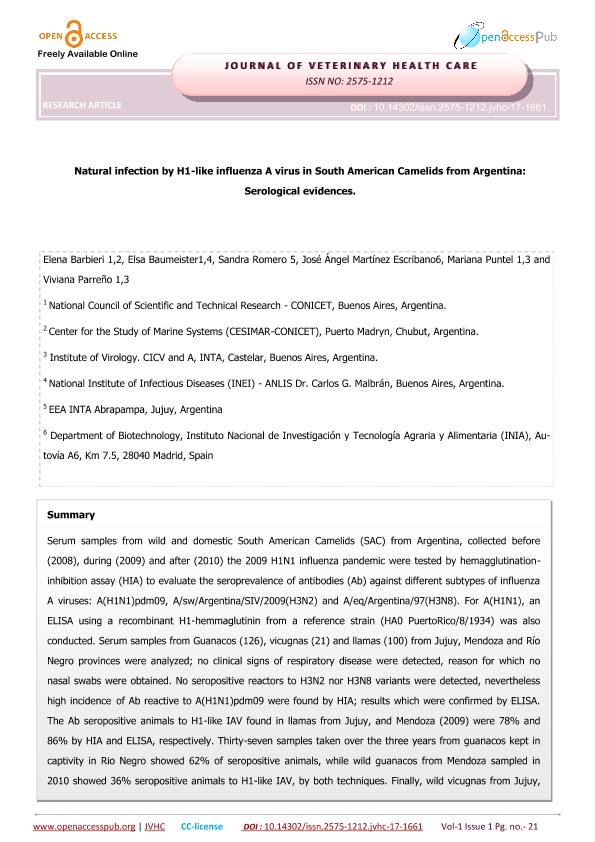Artículo
Natural infection by H1-like influenza A virus in South American Camelids from Argentina: Serological evidences
Barbieri, Elena Susana ; Baumeister, Elsa; Romero, Sandra; Martínez Escribano , José Ángel; Puntel, Mariana
; Baumeister, Elsa; Romero, Sandra; Martínez Escribano , José Ángel; Puntel, Mariana ; Parreño, Gladys Viviana
; Parreño, Gladys Viviana
 ; Baumeister, Elsa; Romero, Sandra; Martínez Escribano , José Ángel; Puntel, Mariana
; Baumeister, Elsa; Romero, Sandra; Martínez Escribano , José Ángel; Puntel, Mariana ; Parreño, Gladys Viviana
; Parreño, Gladys Viviana
Fecha de publicación:
07/2017
Editorial:
Open access pub
Revista:
Journal of Veterinary Healthcare
ISSN:
2575-1212
Idioma:
Inglés
Tipo de recurso:
Artículo publicado
Clasificación temática:
Resumen
Serum samples from wild and domestic South American Camelids (SAC) from Argentina, collected before (2008), during (2009) and after (2010) the 2009 H1N1 influenza pandemic were tested by hemagglutinationinhibition assay (HIA) to evaluate the seroprevalence of antibodies (Ab) against different subtypes of influenza A viruses: A(H1N1)pdm09, A/sw/Argentina/SIV/2009(H3N2) and A/eq/Argentina/97(H3N8). For A(H1N1), an ELISA using a recombinant H1-hemmaglutinin from a reference strain (HA0 PuertoRico/8/1934) was also conducted. Serum samples from Guanacos (126), vicugnas (21) and llamas (100) from Jujuy, Mendoza and Río Negro provinces were analyzed; no clinical signs of respiratory disease were detected, reason for which no nasal swabs were obtained. No seropositive reactors to H3N2 nor H3N8 variants were detected, nevertheless high incidence of Ab reactive to A(H1N1)pdm09 were found by HIA; results which were confirmed by ELISA.The Ab seropositive animals to H1-like IAV found in llamas from Jujuy, and Mendoza (2009) were 78% and 86% by HIA and ELISA, respectively. Thirty-seven samples taken over the three years from guanacos kept in captivity in Rio Negro showed 62% of seropositive animals, while wild guanacos from Mendoza sampled in 2010 showed 36% seropositive animals to H1-like IAV, by both techniques. Finally, wild vicugnas from Jujuy, sampled in 2008 showed 38% and 52% seropositive animals to H1-like IAV by HIA and ELISA, respectively. Our results could indicate the potential role of these species as a reservoir of this zoonotic viral agent of high impact in Public Health, and may suggest that SAC populations might have been infected with an influenza strain antigenically related to H1 IAV. . Surprisingly, for llama and guanaco populations sampled over time in Jujuy and Río Negro, respectively, the HIA and ELISA geometric mean Ab titers (GMT) for 2008 were significantly higher than the ones of 2010. In addition, HIA and ELISA Ab titers found in domestic llamas were significantly higher than those detected in wild vicugnas sampled during that year (2008) in Jujuy. New field campaigns are in progress to collect serum samples and nasal swabs in order to isolate and characterize the virus responsible for triggering H1 reactive Abs. These findings remark the need to better understand the dynamics and ecology of influenza A virus within Sacs populations.
Palabras clave:
Influenza Virus H1n1
,
Sudamerican Camelids
,
Seroprevalence
,
Epidemiology
Archivos asociados
Licencia
Identificadores
Colecciones
Articulos(SEDE CENTRAL)
Articulos de SEDE CENTRAL
Articulos de SEDE CENTRAL
Citación
Barbieri, Elena Susana; Baumeister, Elsa; Romero, Sandra; Martínez Escribano , José Ángel; Puntel, Mariana; et al.; Natural infection by H1-like influenza A virus in South American Camelids from Argentina: Serological evidences; Open access pub; Journal of Veterinary Healthcare; 1; 1; 7-2017; 21-38
Compartir
Altmétricas



